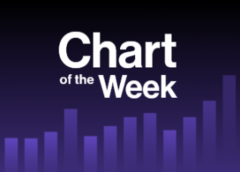
Chart of the Week: Disruptive Tech Diversification
[ad_1]
Advisors are primarily using thematic ETFs to complement a more broadly diversified portfolio, according to VettaFi’s data. In a recent webcast we hosted with ARK Invest, we polled advisor attendees to ask “How much exposure do you have to disruptive technology (such as fintech and blockchain technology)?” While approximately 8% had at least one-fifth of assets invested in these high-risk/high-reward strategies, the majority (56%) had less than one-tenth of assets dedicated to this investment style. Interestingly, 20% of the advisors who attended the webcast who focused on thematic investing and responded to the question had no exposure.
While the poll question asked about disruptive technology, we think many advisors are using the phrase to describe their thematic investing. At the end of July, thematic ETFs managed $93 billion in assets spread across 258 products, according to Global X, representing 1.4% of the ETF industry’s total assets under management. Global X considers an ETFwhether managed by them or peers, to be thematic if it is focused on long-term, growth-focused strategies; is unconstrained by geographies and sectors; and is relatable to concepts that impact daily lives.
With $19 billion in assets, ETFs tied to the climate change mega theme, part of the physical environment category, were particularly popular in July. There were approximately 40 ETFs in the climate change mega theme, including the Global X Green Building ETF (GRNR ) and the Neuberger Berman Carbon Transition & Infrastructure ETF (NBC )which launched in 2022.
The variety of products is favorable with the passing of the Inflation Reduction Act by the Senate in early August, and Congress being expected to devote hundreds of billions of dollars to clean energy sources and reducing the U.S. dependence on fossil fuels in the next decade. This spending will impact a variety of industries.
The iShares Global Clean Energy ETF (ICLN ) is the largest of these climate change-focused products, with $5.6 billion in assets at the end of July among ETFs, but the Invesco Solar ETF (TAN )the First Trust Nasdaq Clean Edge Green Energy ETF (QCLN )and the Invesco Water Resources (PHO ) are sizable investments with $2.9 billion, $2.2 billion, and $1.8 billion, respectively.
These ETFs all seek to combat climate change, but they perform differently. For example, TAN and ICLN were up 10% and 6.6% year-to-date through August 5, but QCLN and PHO were down 6.0% and 14%, respectively. TAN and ICLN had overlapping holdings such as Enphase Energy and SolarEdge Technologies. ICLN’s top holdings also included Consolidated Edison and Vestas Wind Systems. Meanwhile, PHO owned companies such as Danaher and Ecolab.
Advisors likely own shares of many of the clean energy-oriented companies found in these ETFs in a more broadly diversified U.S. equity ETFalbeit in smaller stakes. This is why many advisors allocate between 1% and 10% of assets to thematic ETFs to provide more targeted exposure and potentially reap the long-term rewards without taking on undue risk.
To see more of Todd’s research, reports, and commentary on a regular basis, please subscribe here.
For more news, information, and strategy, visit the Thematic Investing Channel.
[ad_2]
Source link


